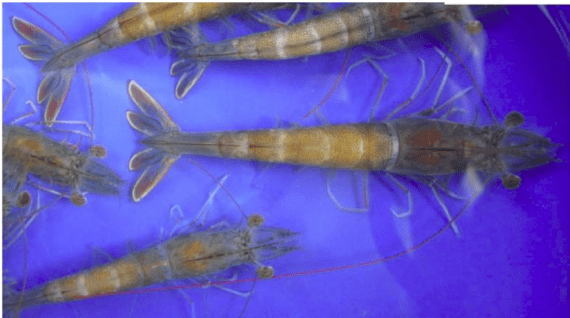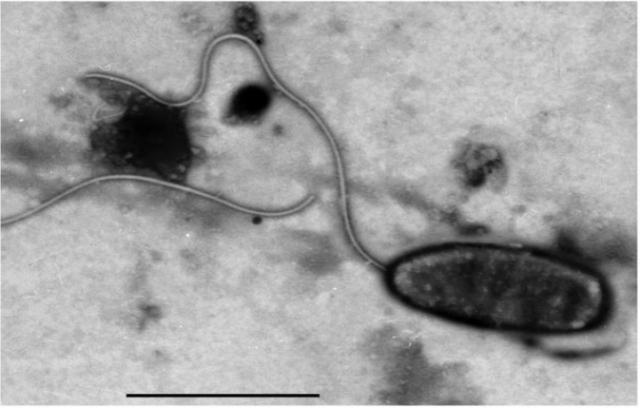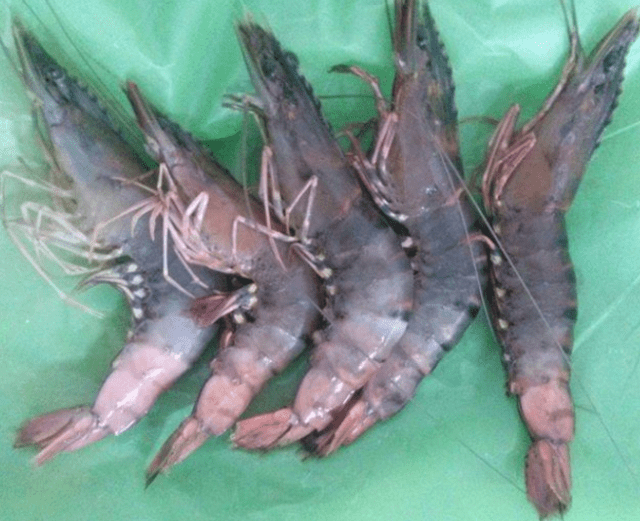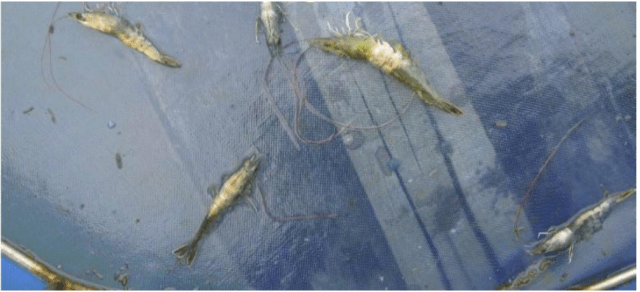Causes
- There are many causes of muscle necrosis disease, white tail, opaque muscle in shrimp. The general sign of this disease is that the tail muscle or muscle in other body segments or the whole body is white or opaque and shows signs of necrosis. The causes/cases of muscle turbidity in shrimp are as follows:
– Chiropractic combined with body curvature: This usually happens when lifting the boat (floor, hooves) out of the water during the day, when the temperature is very hot. Shrimp jumped up and flicked hard, and then some of them bent their bodies. The tail bends to reach the breastplate, at the same time the muscle tissue running along the middle of the body will become milky white. After being released back into the pond, all bent shrimp will die because of their inability to straighten themselves. Similarly, when testing shrimp in hot weather, shrimp also whitened and curled their body. The best way to limit it is not to lift it out of the water or use a fishing net to check shrimp in hot weather. This phenomenon also sometimes occurs when turning off all water fans when feeding shrimp and then turning the fan back on. The resumption of fans can cause shrimp to “startle” and many to jump to the surface creating a “wave” running along the pond. This phenomenon usually occurs late at night, some of them bent their body when exposed to air and turned white. Often farmers do not pay attention to this phenomenon and only find dead shrimp in the pond the next day. This problem often occurs when the weather is hot and, in the pond, there are many species of algae growing. The high density of thyroid algae makes the water reddish brown and the shrimp weak. The best way to prevent shrimp from jumping to the surface due to shock from turning on the fan is when the shrimp reaches 10 grams/head or larger, the farmer should keep several fans running, even while feed the shrimp. The high density of thyroid algae makes the water reddish brown and the shrimp weak. The best way to prevent shrimp from jumping to the surface due to shock from turning on the fan is when the shrimp reaches 10 grams/head or larger, the farmer should keep several fans running, even while feed the shrimp. The high density of thyroid algae makes the water reddish brown and the shrimp weak. The best way to prevent shrimp from jumping to the surface due to shock from turning on the fan is when the shrimp reaches 10 grams/head or larger, the farmer should keep several fans running, even while feed the shrimp.
– Turbidity due to transport or to pond: When trawling to catch shrimp for the purpose of trimming or to pond, some shrimp will be stressed and part or all of its muscle will become white, or occasionally there is a mixture of white and unusual dark colors such as orange or rose red. Most of these unusually colored shrimps will die. Others have mild symptoms, if they recover, it will take a few days for the body color to return to normal. The best measure is to check the shrimp health before moving to a new pond. If the shrimp is healthy, it can withstand stress. If farmers start to transfer shrimp and find that some of them turn milky, it should be postponed. The water used for transporting shrimp must have a temperature of 24-25 0C and the oxygen content must be high.

– Muscle turbidity due to low oxygen content: The amount of oxygen in the pond water will be low if there are not enough fans to match the number of shrimp in the pond. According to experience, each electric horsepower (HP) fan will provide enough oxygen for 400-500 kg of white leg shrimp. Farmers should calculate the number of water fans just enough to provide oxygen for the amount of shrimp in the pond. In addition, the location of the water fan is also very important, installing the water fans in the right position will create a flow that sweeps waste into the middle of the pond, making the bottom of the pond always clean, and at the same time making oxygen diffuse. everywhere in the pond, especially in the middle of the pond, where the decomposition of organic matter accumulated from dead algae and excess food takes place. The decomposition of organic matter increases during the growing season and this is the cause of low oxygen in the water. Organic waste accumulated in the pond will be decomposed by microorganisms and their life activities require a large amount of oxygen. When it’s cloudy or raining for several days in a row, the algae won’t be able to photosynthesize well and won’t produce as much oxygen. Meanwhile, every organism living in the pond including shrimp, algae and microorganisms uses oxygen. Dissolved oxygen in the water is uneven and very low in the middle of the pond, especially in ponds where there is no regular water exchange and high stocking density of shrimp. When there are many shrimps, farmers have to provide a lot of food and the pond water color will be dark because of dense algae growth. If the oxygen in the shrimp pond is 4 ppm or more, the white leg shrimp’s body has a normal light color. But in ponds with high density and low dissolved oxygen, shrimp will be stressed and the body will tend to turn white or opaque. When the oxygen content drops to 1, 7 ppm shrimp will swim to the surface (shrimp will float) and most will die when molting. This phenomenon has also been demonstrated in the laboratory Aquaculture Business Research Center of Kasetsart University, Thailand. Shrimp were reared in glass tanks with adequate aeration. When the aerator is turned off, the oxygen in the water decreases and the shrimp activity decreases. Shrimps do not swim much and tend to stay near the bottom of the tank. Shrimp will not die or swim sluggishly to the surface even if the oxygen in the water is less than 1 ppm. However, when the oxygen content was lower, most shrimp showed signs of muscle tissue becoming milky. Some fish only white at the base of the swimming legs. When the aerator is turned off, the oxygen in the water decreases and the shrimp activity decreases. Shrimps do not swim much and tend to stay near the bottom of the tank. Shrimp will not die or swim sluggishly to the surface even if the oxygen in the water is less than 1 ppm. However, when the oxygen content was lower, most shrimp showed signs of muscle tissue becoming milky. Some fish only white at the base of the swimming legs. When the aerator is turned off, the oxygen in the water decreases and the shrimp activity decreases. Shrimps do not swim much and tend to stay near the bottom of the tank. Shrimp will not die or swim sluggishly to the surface even if the oxygen in the water is less than 1 ppm. However, when the oxygen content was lower, most shrimp showed signs of muscle tissue becoming milky. Some fish only white at the base of the swimming legs.
– Cataract due to disease: In addition to the above cases, shrimp can also opaque due to disease. Currently, there are many studies that have determined that the cause of myositis in whiteleg shrimp is due to disease, such as infection with microsporidian (Microsporidian), or virus (IMNV, PvNV) or due to disease. Infection with bacteria of the Vibrio group (Vibrio harveyi is named “bacterial white tail disease” in culture areas with relatively high salinity (25-35‰), shrimp turn opaque white in some parts of the body, but the cause is not due to stress, but often due to microsporidian (Microsporidian).In addition, shrimp infected with infectious myonecrosis virus (IMNV), or muscle necrosis disease on white leg shrimp caused by nodavirus (PvNV – Penaeus vannamei nodavirus). The two viruses IMNV and PvNV have many similarities with nodavirus causing white tail disease (WTD) in giant freshwater shrimp (MrNV – Macrobrachium rosenbergii nodavirus). Both of these viruses first attack the shrimp muscle and have similar clinical manifestations of whiteness or opacity in the caudal muscle on the shrimp family. Small necrotic spots start at the tail and then gradually spread to the whole body. The cumulative mortality rate is quite high, about 40-70%.
- So far, there is no cure, but mainly apply integrated disease prevention measures such as not using infected broodstock in hatcheries, removing diseased shrimp from ponds and doing good work. pond renovation.





 Tiếng Việt
Tiếng Việt Indonesia
Indonesia